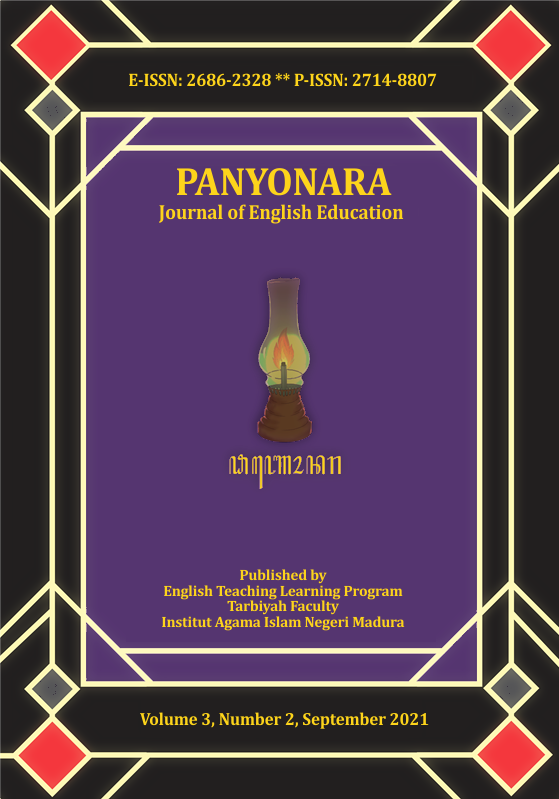The Impact of Multisensory Method on Students’ Memorizing Vocabulary at Halimah Kindergarten Prenduan Sumenep
 Abstract views: 559
,
Abstract views: 559
,
 PDF downloads: 568
PDF downloads: 568
Abstract
Young learners were aged 5-6 have a golden age to master a new language since they have good memorization in their brains. It is similar to the phenomenon at Halimah Kindergarten Prenduan Sumenep. 11 students had mastered their first language (Indonesian) 8 of 11 students among them cannot answer the teacher's question about English vocabulary of profession after the teacher taught learning vocabulary in the classroom. Additionally, the students are still difficult to answer the questions. Ultimately, this research measures whether kindergartens students learning vocabulary with the Multisensory Method have better-memorizing vocabulary and the significant impact of the Multisensory Method after treatment. The researcher conducted research using a quantitative approach with consist pre-experimental design. The data was obtained by observing pre-test and post-test. Likewise, documentation was used to legitimize the data. The data result found that learning vocabulary for the young learner is easier to understand if the teacher applies a multisensory method (t value: 5.164) which is higher than t table 2.23. Hence, the multisensory method is an excellent method to be applied for kindergarten in the classroom.
Downloads
References
Ahearn, M. (2016, December 12). The OG Approach | Academy of Orton-Gillingham Practitioners and Educators. Retrieved September 27, 2021, from https://www.ortonacademy.org/resources/og-approach-principles/
Alqahtani, M. (2015). The Importance of Vocabulary in Language Learning and How to be Taught. International Journal of Teaching and Education, 4(3), 21–34.
Arikunto, S. (2010). Prosedur Penelitian: Suatu Pendekatan Praktik. Jakarta: Rineka Cipta.
Baharuddin. (2008). Psikologi Pendidikan. Solo: Tiga Serangkai.
Bhinnety, M. (2015). Struktur dan Proses Memori. Buletin Psikologi, 16(2), 74–88. doi: 10.22146/bpsi.7375
Celik Korkmaz, S., & Karatepe, C. (2018). The Impact of Multi-Sensory Language Teaching on Young English Learners’ Achievement in Reading Skills. Novitas-ROYAL (Research on Youth and Language), 12(2), 80–95.
Darling-Hammond, L., Flook, L., Cook-Harvey, C., Barron, B., & Osher, D. (2020). Implications for Educational Practice of the Science of Learning and Development. Applied Developmental Science, 24(2), 97–140. doi: 10.1080/10888691.2018.1537791
Gunawan, Adi. W. (2006). Genius Learning Strategy Petunjuk Praktis untuk Menerapkan Accelarated Learning. Jakarta: Gramedia.
Hamida, A. (2016). The Effectiveness of Personal Vocabulary Notes (PVN) Technique in Improving Students’ Vocabulary Achievement in the First Grade Students at SMP Islam al-Azhaar (Thesis). IAIN Tulungagung.
Hiebert, E. H., & Kamil, M. L. (2005). Teaching and Learning Vocabulary: Bringing Research to Practice. London: Routledge.
Hoye, C. (2018, March 28). Benefits of the Multisensory Approach in the Classroom. Retrieved September 27, 2021, from The Gateway School website: https://thegatewayschool.com/multisensory-approach-special-education/
Jubran, S. (2012). Using Multisensory Approach for Teaching English Skills and Its Effect on Students’ Achievement at Jordanian Schools. European Scientific Journal, ESJ, 8(22). doi: 10.19044/esj.2012.v8n22p%p
Maliki, N., & Yasin, M. (2017). Application of Multisensory in Learning Alphabets Identification Skills for Special Education Students. Journal of ICSAR, 1(2), 150–154. doi: 10.17977/um005v1i22017p150
Nurhayati, E. (2011). Psikologi Pendidikan Inovatif. Yogyakarta: Pustaka Pelajar.
Obaid, M. A. S. (2013). The Impact Of Using Multi-Sensory Approach For Teaching Students with Learning Disabilities. Journal of International Education Research (JIER), 9(1), 75–82. doi: 10.19030/jier.v9i1.7502
Pratiwi, A. F. (2017). Peningkatan Daya Ingat Anak Usia Dini Melalui Media Mind Mapping pada Kelompok B di TK Islam al-Muttaqin Kota Jambi (Tesis). Universitas Jambi.
Praveen, A. V. (2010, August 6). What are Multisensory Instruction Techniques for Teachers and Parents? Retrieved September 27, 2021, from Learning Center for children who learn differently, their teachers and parents in Dubai, Middle East website: https://www.lexiconreadingcenter.org/what-is-multisensory-teaching-techniques/
Rabbianty, E. N. (2013). Teaching English to Young Learners. Surabaya: Salsabila Creative.
Soemanto, W. (2006). Psikologi Pendidikan. Jakarta: PT. Rineka Cipta.
Suyanto, K. K. E. (2007). English for Young learners. Jakarta: Bumi Aksara.
Tutupoly, J. F., Siswati, & Widodo, P. B. (2013). Efektivitas Metode Multisensori Terhadap Kecakapan Mengingat Kosakata Bahasa Inggris pada Siswa Kelas 1 Sekolah Dasar (Studi Eksperimental di SD Negeri Tembalang Semarang). Jurnal Psikologi Universitas Diponegoro, 12(2), 100–108.
Utami, S. (2015). The Students’ Ability in Using Derivational Suffixes. Jurnal Cemerlang, 3(1), 19–27.
Willis, J. (2008). How Your Child Learns Best. Illinois: Sourcebooks Inc.
Zhou, M., & Brown, D. (2015). Educational Learning Theories (2nd ed.). Georgia: Dalton Stage College. Retrieved from https://oer.galileo.usg.edu/education-textbooks/1
The journal uses an Open Access policy under a Creative Commons Attribution-NonCommercial 4.0 International License. Authors who publish with this journal agree to the following terms:
- Authors retain copyright and grant the journal right of first publication with the work simultaneously licensed under a Creative Commons Attribution License that allows others to share the work with an acknowledgment of the work's authorship and initial publication in this journal.
- Authors are able to enter into separate, additional contractual arrangements for the non-exclusive distribution of the journal's published version of the work (e.g., post it to an institutional repository or publish it in a book), with an acknowledgment of its initial publication in this journal.
- Authors are permitted and encouraged to post their work online (e.g., in institutional repositories or on their website) prior to and during the submission process, as it can lead to productive exchanges, as well as earlier and greater citation of published work.
















